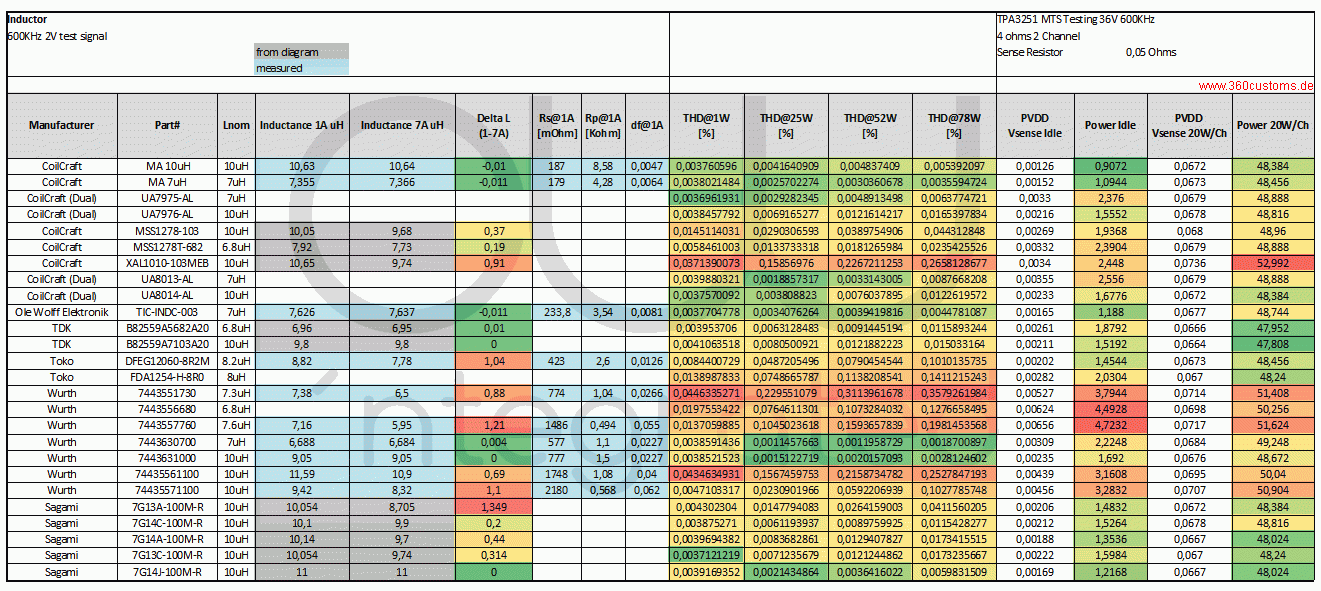Nonsense again. No need to recommend Lloyd Dixon to me, I know and appreciate his contributions for ages. A simple physics textbook will tell you that you are wrong. Following your logic, by reducing the size of a core we get the smallest losses. Brilliant! You are really funny!
For TPA32XX amps, inductors make a difference...
Flat wire inductors perform better.
Allo has spent a lot of time in their R&D to develop new air core type inductors for the next TPA3255
The Topping PA5 is using great inductors, you can see the ASR review so you can understand how it performs so good.

Flat wire inductors perform better.
Allo has spent a lot of time in their R&D to develop new air core type inductors for the next TPA3255
The Topping PA5 is using great inductors, you can see the ASR review so you can understand how it performs so good.

Hi ernperkins
Does the amp go into fault mode playing music? Drawing full power on all channels continuously can of course a big ask on a small and amp like this 😉
Anyway before changing output coils or output caps etc. (which I do not believe is the problem) you could check how the chip's fault detection is configured.
Leg 6 is the Power limit input, which should be connected to a cap + 1 or 2 resistors.
The resistor is determining the power limit (the cap is ensuring stability for the power measurement) as I read the data sheet.
I'm no expert at all on 3116, but maybe you could get more out by changing the limit, if it is set to limit before full power.
Does the amp go into fault mode playing music? Drawing full power on all channels continuously can of course a big ask on a small and amp like this 😉
Anyway before changing output coils or output caps etc. (which I do not believe is the problem) you could check how the chip's fault detection is configured.
Leg 6 is the Power limit input, which should be connected to a cap + 1 or 2 resistors.
The resistor is determining the power limit (the cap is ensuring stability for the power measurement) as I read the data sheet.
I'm no expert at all on 3116, but maybe you could get more out by changing the limit, if it is set to limit before full power.
Just a side thought, does it run hot in idle? I ask because the tpa3116 datasheet contains an error for the sync filter for connecting chips together.
Thanks for all the replies and information (even the tangent discussion/disagreement about inductor losses). I don’t believe the fault will occur in my use case: one amp per three way speaker. In that situation one 3116 will drive a tweeter and a mid with the PBTL 3116 driving the woofer. The tweeter channel will be using a lot less power than the mid and I don’t intend to drive the mid beyond 25W/channel. And as Baldin commented, driving all channels continuously with a sine wave is asking a lot for an inexpensive amp like this.
All in all I’m very pleased with this TinySine 7800B “all-in-one” amp: Bluetooth with AptX & True Wireless Sound, ADAU1701 DSP and 3116 based amps for $75. I’ve done a lot of THD and 1 KHz spectrum tests using both the analog and Bluetooth inputs and find it very acceptable for $75. I also tested a similar featured product from Sure Electronics/Wondom (the JAB5) and the TinySine product outperformed it in every way.
All in all I’m very pleased with this TinySine 7800B “all-in-one” amp: Bluetooth with AptX & True Wireless Sound, ADAU1701 DSP and 3116 based amps for $75. I’ve done a lot of THD and 1 KHz spectrum tests using both the analog and Bluetooth inputs and find it very acceptable for $75. I also tested a similar featured product from Sure Electronics/Wondom (the JAB5) and the TinySine product outperformed it in every way.
I do all my testing with REW so you’ll need to install REW (it’s free) to view the tests. Here’s a dropbox link to my test file:
https://www.dropbox.com/s/shh5u6pdhibpe6x/7800B amp measurements.mdat?dl=0
For testing I use an older Dell Workstation laptop running on battery. It's connected to and powers a Focusrite Solo USB interface. I used a Meanwell LRS-350-24 to power the amp. I also use a symmetrical adjustable attenuator on the amp outputs.
A few notes:
https://www.dropbox.com/s/shh5u6pdhibpe6x/7800B amp measurements.mdat?dl=0
For testing I use an older Dell Workstation laptop running on battery. It's connected to and powers a Focusrite Solo USB interface. I used a Meanwell LRS-350-24 to power the amp. I also use a symmetrical adjustable attenuator on the amp outputs.
A few notes:
- The first test is a baseline loopback of my Focusrite Solo USB interface
- I purchased two 7800B amps. Curiously one has inductors marked “M121” and the other “M161”. Tests 3- 20 are the “M121” board and tests 22-34 are the “M161” board.
- The title of each test lists the power and channel tested. The “-x dB” in each title is just the setting of my adjustable attenuator for that test.
- Selecting a particular test opens a text box where I’ve put additional information.
Last edited:
For any Class-D amplifier the inductors make a (huge) difference.For TPA32XX amps, inductors make a difference...
In fact, it's one of the most significant distortion factors inside a Class-D amplifier.
Sadly enough a lot of developers don't seem to realize this and use either inductors that are to small (read: saturate to soon), or even use iron powder inductors, which saturate very soft, but very early.
https://codaca.com/uploads/product/pdf/cn/CPD1415B.pdfI was hoping to find some information on the inductor's specs to see if that made sense.
Does it similar like this one ?
- Home
- Amplifiers
- Class D
- Source of "no name" inductors?